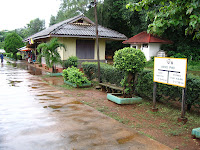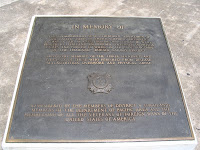There are a number of plaques, sculptures and monuments that are placed around the Bridge either by foreign countries who participated in the war or the locals. Couple of my favorites: if you ever watched a World War 2 movie where the Yanks are the only ones fighting either the Gerrys or Japs, this is proof that its not only Hollywood producers that believe this take on history - the US plaque built by American veterans who pay tribute to the American soldiers who were interned by the Japanese, the Americans who built the Bridge/Railway and the Americans that perished during its construction (apparently the British, Dutch and Australian POWs were just hanging around).
There is a huge sculpture of the word “war” placed around the plaza near the Bridge. Next to this is another word sculpture (the green one), I wasn’t sure what it said and assumed it was written in the Thai alphabet “maybe the Thai word for war”. Being the thorough, informative tourist that I am I enquired with the tour operator what the word meant? He looked at me a bit confused and explained that it was the English word for “all” (maybe if I had taken the photo from the other side). These 2 plus a couple of others make up the phrase “all war is evil” (if they had placed the words in the correct order and face the same way I wouldn’t look like a tool).
This part of the Railway has a tourist train (the real Railway train comes later) that crosses the Bridge and back. As noted in earlier photos, you can walk along the Bridge. So when the train starts across the Bridge and you happen to be walking across it at the time you had better get out of the way as the train will just run right over you. The driver or someone on the train just yells at you (in Thai) to get the fuck out of the way as it is coming (as if the big yellow engine wasn’t warning enough). There are a number of sections on the Bridge that you can take refuge on, but if these are full then you are added to the toll of the Bridge. I took this photo and have passed it on the families of the people in the picture as a way for them to remember them.
A little journey from the Bridge took a ride on the Death Railway on the Death Train starting at the Death Station of Wang Pho. I purchased my Death Train-ticket and hoped upon a Death Carriage (nice shade of blue) and took a Death Train Seat next to a Death Train Window. The Death Train Conductor (who looked like he wouldn’t be out of place in the Imperial Army out of Star Wars) punched my Death Train-ticket Stub and oversaw my Death Security on the trip (mainly by smoking cigarettes and picking his nose). On my Death Voyage I was able to purchase a Death Can of Coca-Cola and a Death Cornetto Ice Cream.


During the trip you pass through the Thai country-side and you start to get an idea of how rough the going would have been trying to build the Railway. As you pass along the river and through the jungle you can see the atrocious physical conditions the POWs would have had to work under let alone being mistreated by their guards and during a time of war. It was done without any machines, entirely by hand which makes it astounding that it was achieved at all. You pass by campsites, caves and gullies which were used by the POWs to live in and treat their sick. There is the cave that the famous Australian medical officer Weary Dunlop operated on hundreds of men while working on the railway. The trip takes about 30 minutes taking you back to Kanchanaburi.
That night spent the night on a river boat beside the River Kwai. This looked to be a very tranquil setting at the end of a long day. But the place was invaded by mosquitoes and having read in the local paper about record levels of Dengue fever in Thailand meant that I became a prisoner of my room (that was a poor choice of an analogy considering the topic). The room was like a big wicker basket, felt like a snake. Chose to stay in rather then go out and explore the town as I was buggered. Watched TV which was all local Thai channels featuring solely soap operas. The action on these shows consists of the female characters performing the following in each episode: crying, talking to yourself, attacking and screaming another character (actually, much like most women).


Despite some pretty ordinary efforts to cash in on the tourist interest in the place, well worth the visit to such an significant historic place.
Fin.







No comments:
Post a Comment